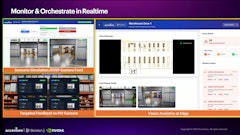
Data analysis has become essential to maintaining a competitive edge in today’s technology-driven environment defined by volatility, complexity, and increasing customer demands. This means reactive strategies for supply chain management are a thing of the past for all business sectors. Predictive and prescriptive analytics are now key to proactively managing risk, optimizing operations, and enhancing resilience. Analytics and the diverse data that supports it have transformed modern manufacturing and will continue to revolutionize the speed and nuance with which supply chains can be managed.
While the benefits of utilizing analytics are clear, the path to adopting these capabilities often meets significant challenges. Organizations need to blend daily operating requirements with compatible technologies and designated capital and are often met with additional hurdles related to legacy data, system complexity, skills, and culture. Understanding the challenges to establishing predictive and prescriptive analytics is critical to planning implementation strategies that allow manufacturers to successfully leverage their data and optimize their supply chain to be future-ready.
Defining predictive and prescriptive analytics
Predictive analytics compiles, integrates, and analyzes diverse data, such as historical, real-time, customer/supplier, and market data, to forecast future trends and understand impacts on supply chain dynamics. Businesses commonly use predictive insights for production planning, inventory optimization, predictive maintenance, resource planning, and risk mitigation.
A range of methodologies supports predictive analytical capabilities, including statistical algorithms, machine learning, and, most recently, AI-driven modeling. Advancements in real-time data modeling have led to the evolution of predictive analytics into enhanced prescriptive analytics: the ability to recommend optimal actions based on predictive insights and specific objectives. Utilizing prescriptive analytics allows manufacturers to proactively manage supply chains, enabling beneficial activities such as fine-tuning manufacturing schedules based on market demand signals and capacity constraints, and dynamically adjusting sourcing based on forecasted supplier disruptions.
By leveraging predictive and prescriptive analytics, organizations can drive breakthrough strategic decision-making and generate forward-looking action plans to enable a more agile, resilient, and customer-focused supply chain.
Implementation challenges and strategies for success
While the benefits of using analytics are obvious, the worthwhile journey to arrive at this data-driven, nimble future state is not without its potholes. Barriers to successfully implementing predictive and prescriptive analytics range in complexity depending on organizational readiness. Understanding the common hurdles related to data, technology, skills, and organizational change is critical for designing an implementation strategy that minimizes risk by incorporating both comprehensive and targeted solutions specific to a company’s current state and strategic objectives.
Data integrity and readiness
Perhaps the most obvious challenge to harnessing the power of data analytics is the data itself. Manufacturers often operate in fragmented IT environments with data scattered across ERP, MES, WMS, and supplier systems. Poor data integration, outdated information, and a lack of standardization undermine analytics initiatives, leading to unreliable insights. A data readiness assessment provides an organization with a solid foundation for tackling messy data by reviewing current data assets, identifying gaps, and establishing data governance standards. Once the gaps are identified, data quality initiatives can be prioritized to achieve reliable analytics outcomes.
Technology integration
Together with assessing data quality, organizations must also evaluate their system stacks. Integrating predictive and prescriptive analytics tools with legacy systems often presents technical challenges, and the associated complexity is a common tripping point. Minimizing risk and disruption to supply chain activities is vital and requires careful planning and execution as part of the implementation strategy. Manufacturers should prioritize the selection of scalable, flexible solutions such as analytics platforms that offer modular deployment and seamless integration with existing systems. These characteristics will ensure strong interoperability and help minimize supply chain disruptions. Robust cloud capabilities and user-friendly interfaces should also stay top of mind for supporting system longevity and enhancing the utility of data insights.
Data literacy
Analytical capability supported by data integrity and an optimized IT environment is a powerful tool in the right capable hands. There is a limited pool of professionals who possess both supply chain domain expertise and analytical skills. Without internal resources capable of translating data outputs into sound business cases and operational improvements, an investment in implementing analytics will fail to realize sustained value. Here, data literacy is either a stumbling block or the key that ignites the engine. A successful implementation plan should include workforce development programs to upskill existing supply chain personnel in data literacy and analytics fundamentals. Building cross-functional teams that blend operations knowledge with data science expertise is critical in a data-driven market where data literacy is the new language of business.
Change management
Adoption of advanced analytics within an organization is an involved undertaking that often encounters resistance. Longstanding reliance on manual processes and intuition can create skepticism toward algorithmic decision making, and concerns over job displacement contribute to cultural barriers. Proactively address opposition and prevent confusion by incorporating comprehensive change management throughout the implementation plan. The effective use of change management improves stakeholder engagement, user adoption, adaptability, and innovation, all enabling supply chain-driven organizations to adjust rapidly. This is especially important when implementing advanced analytics since user adoption (engaging with the new analytic capabilities) is how value is realized.
As part of a wholistic change management strategy, manage expectations with targeted communications and champion the benefits of analytics as a tool for efficient decision-making, not as a replacement for human expertise. Include data literacy education as part of a broader training program to support supply chain personnel in understanding the specifics of the changes that will impact their roles. Effective change management will help smooth the twists and turns of an analytics implementation journey and empower dynamic supply chain transformation.
Bite-sized transformation
Our brief exploration of these four main challenges to establishing predictive and prescriptive analytics for manufacturing illustrates the complexity of these efforts. Manufacturers operating under tight margins may be hesitant to invest in advanced analytics without clear short-term ROI. High initial costs for technology, integration, and training further complicate the investment decision. Address these barriers by breaking it down into bite-sized pieces by selecting targeted pilot projects. Begin with focused, high-impact use cases that demonstrate tangible value. Examples include predictive maintenance in a key production facility or inventory optimization for critical components. Successful pilots can build organizational buy-in, justify broader rollouts, and even free up additional capital to reinvest in broader implementation efforts. First, developing a successful implementation plan considering data, technology, skills, and change management for a limited-scope effort will provide important insights for successfully navigating the complexities of larger efforts. It’s important to remember there’s not a one-size-fits-all implementation plan, and the intricacy of the effort is dependent on the size and complexity of an organization.
Modern-day necessity of analytics
Adopting predictive and prescriptive analytics has become a strategic imperative essential to the success of modern manufacturing supply chains in a fast-paced, technology-oriented environment. Organizations that effectively harness these capabilities will be better positioned to respond dynamically to market shifts, proactively mitigate operational risks, and deliver superior, more efficient customer service. Manufacturers must move beyond traditional models and embrace a data-driven future to achieve operational excellence and sustainable growth.
By addressing data challenges, building internal capabilities, managing change effectively, and making strategic technology investments, manufacturing organizations can unlock the full potential of predictive and prescriptive analytics and transform their supply chains into competitive advantages. The future supply chain will be defined not just by the physical movement of goods but by the intelligent application of data and insights. Manufacturers that invest in building these capabilities today will outpace everyone else.



















